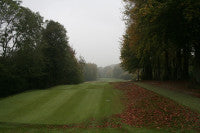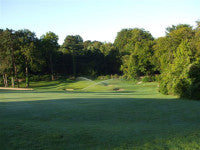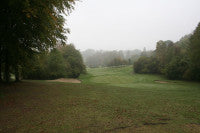Tyrrells Wood
 Billy McMillan is one of five brothers who are all Greenkeepers. He is also the outgoing BIGGA Chairman and has worked tirelessly to improve the standing of all Greenkeepers during his tenure. Report by Laurence Gale MSc
Billy McMillan is one of five brothers who are all Greenkeepers. He is also the outgoing BIGGA Chairman and has worked tirelessly to improve the standing of all Greenkeepers during his tenure. Report by Laurence Gale MSc
With its unusual mix of parkland and downland, plus a Grade II listed clubhouse, Tyrrells Wood has long been recognised as one of the finest golfing venues in Surrey.
The original course was designed by five times Open Champion James Braid, one of the most respected and prolific course designers of his day. Later improvements were made by Harry Colt.
The course, near the town of Leatherhead, is set among a myriad of specimen trees framing magnificent views of the surrounding countryside. At between 300 and 600 feet above sea level it provides a wonderful setting for golf.
The Club opened for regular play in 1923. By 1924 Major Henry Keswick, the proprietor, had persuaded the very high profiled Sir Rowland Blades to become the first captain, a position he held for three years. During that time he was also Lord Mayor of London. By late 1928 the club was a flourishing concern with some 400 Members. Today the club boasts a healthy membership of 900.
The typical downland nature of the area was transformed by a substantial tree planting programme implemented in the late 19th century which continues to this day to maintain the character of the course.
The chalk down slopes provide an ideal free draining soil that supports the natural habitat. There are over ten species of wild orchids along with many other interesting flowers and fauna.
Although the course has undergone continuous improvement over the years, care has been taken to preserve Braid's unique approach to green and bunker design. The course has seventy six bunkers which provide their own individual challenges to both the players and groundstaff alike.
The greens are soil pushed up and are managed under a traditional maintenance regime of cutting, feeding, verticutting, topdressing and aeration.
The course is maintained by a team of seven including the Course Manager who works tirelessly to maintain the high standards demanded by the members, management and, indeed, the Greenkeepers themselves.
 The Course Manager is none other than Billy McMillan, the current BIGGA Chairman who, like many previous encumbants of the position, has a strong affinity with Greenkeeping having spent over thirty years working in golf course management.
The Course Manager is none other than Billy McMillan, the current BIGGA Chairman who, like many previous encumbants of the position, has a strong affinity with Greenkeeping having spent over thirty years working in golf course management.
Billy has been a Greenkeeper all his working life coming into the industry at the age of sixteen. In his time he has been a Course Manager at nine different golf courses. but says he has lost count of the ones he worked at on his way up the ladder!
Billy has been at Tyrrells Wood for four years and, in that time, has continued to make improvements to the course. He's got a long way to go to beat the previous Head Greenkeeper, Bert Watson, who held the position for forty seven years!
Billy suggests that greenkeeping is not all rocket science and that there are plenty of traditional practices that can be undertaken to set the required standards for today's golfer. Most of the work at a golf course is ongoing and could even be termed as repetitive. It is all about doing these basic tasks quickly, efficiently and to the best of your ability, using products and services you have at hand and the club can afford.
The Greenkeepers set-up at Tyrrells Wood is comparable to many 18 hole courses in the UK with a simple layout of workshops, office and mess room. Billy understands that the whole economy of the course is driven by the income that is generated from golfers. It is a fine balance between having the best facilities in the clubhouse and pro shop and investment on the course, as both make demands on the available funds.
Billy has six staff who, between them, have all the skills necessary to keep the course in the condition the members expect. With today's golfing fraternity expecting all year round golf and the influences that television brings to bear, this is no mean feat.
The course is run by a Board of Management which represents the wishes of the club members. Billy reports to the Director of Golf and regularly attends meetings with him and other members of the board.
The club has a strategic business plan in place to meet the objectives of the members. The plan is made up of short, medium and long term objectives. Within the overall plan Billy has set his own targets for course management and development.
His short term targets are to increase the quality and frequency of grass cutting regimes, looking at different ways to present the course, changing heights of cut and changing the way grass is being managed. Billy says there is a hunger these days for making golf courses longer to accommodate modern golf. At Tyrrells Wood they simply don't have the available land to expand so he and his team will continue to look at ways to make the course as challenging as possible within the available course layout.
Greens are maintained at between 3.5mm in the summer and 5mm in the winter and frequency of cut will depend on growth but, in general, greens are cut daily. Cutting time is around 2.5 hours for one man.
Tees are maintained at 8mm in the summer and 8-10mm in the winter, mowing a minimum of three times per week. Using a Toro Triple, cutting time is between 2-3 hours for one man dependant on golf traffic.
 Fairways are maintained at 14mm in the summer and 16mm in the winter. They are mown five times a week. and take a full day to complete using a Toro 6500.
Fairways are maintained at 14mm in the summer and 16mm in the winter. They are mown five times a week. and take a full day to complete using a Toro 6500.
Collars are kept at 8mm all year round. Semi rough is kept to 33mm and the Long grass areas are left to grow but get one single cut and collect in late November.
Billy has invested in a Bernhards Rapid Facer 1000 bottom blade front facer to ensure his mowing blades are kept sharp on a regular basis. This has proven to be a major benefit in his maintenance programme.
Medium targets centre around the need to make better use of the equipment they have to improve the efficiency of working practices, placing an emphasis on doing the job right first time and on time, and also working within the time frames of weather and golf play. These time frames often dictate the working schedules.
Billy usually begins his first work on the greens in the spring when they deep aerate and topdress with 90/10 sand peat dressing and start the fertiliser programme with an application of 40 grammes per square metre of TX10 fertiliser. Further topdressing and fertiliser are applied on an as and when basis. A dose of liquid iron is also applied to greens and tees to maintain plant health.
Using a newly acquired tractor mounted Wiedenmann aerator, a regular programme of aeration is also implemented to keep the soil based greens open and free draining.
A final renovation programme is carried out in August when temperatures remain favourable for grass recovery. This involves hollow coring and topdressing greens to set then up for winter play. An active aeration programme is then put in place throughout the winter to maintain good drainage andto encourage root development.
Long term targets involve the procurement of machinery and equipment to maintain the standards being set. Recent investment has seen the purchase of a new irrigation system and a healthy complement of on course equipment which has highlighted the fact that course accommodation facilities may require an update sooner rather than later.
All of the equipment is purchased outright s o it is important that the right choices are made. This can only be achieved by thorough investigation and trials. It is important that the staff are also involved in the selection of equipment as, not only are they the ones who will use it but, often, they will put forward sound reasons and arguments for and against.
o it is important that the right choices are made. This can only be achieved by thorough investigation and trials. It is important that the staff are also involved in the selection of equipment as, not only are they the ones who will use it but, often, they will put forward sound reasons and arguments for and against.
None of these targets can be met without the support and agreement of the board members and the dedication and commitment of his staff. Billy works hard at communicating his requirements and is generally successful because of the hard work of his staff on a day to day basis.
Along with the day to day management there are programmes of work that are planned in respect of enhancement and improvement to course habitat and playing conditions.
One thing that needs addressing is the balance of tree cover and impact on the grass management of the course. Shade and air movement are key issues that can determine the quality and condition of the sward on tees, greens and fairways.
Every year Billy initiates a programme tree thinning, pruning and felling. The recent reconstruction of the first green involved the felling of trees to enable the work to be done. This was carried out in-house with all the construction work completed within three weeks.
To achieve all year round golf Billy has also had to put in place a programme of path refurbishments around the course, using artificial grass coverings that blend in well with the existing natural landscape layout of the course.
 This year there are plans to refurbish the path on the 7th tee complex.
This year there are plans to refurbish the path on the 7th tee complex.
All of the work is only achieved, says Billy, because of the complete dedication, passion and commitment of his staff, a trait that is commonly shared by most who choose to work in the golf industry.
During his year as Chairman of BIGGA Billy has had the opportunity to meet many Greenkeepers and Course Managers who share his desire for the industry.
He has been a member of BIGGA since its inception some twenty years ago and has served on various boards, However, the most enjoyable experience to date has been having the opportunity to serve as Chairman.
The people he has met, and the friendships he has formed, have confirmed his beliefs that it's all about people and what they bring to the table. The generosity and support he has received during the last twelve months has given him a new lease of life and a stronger resolve to continue raising the standards of Greenkeeping and, more importantly, attract newcomers to the industry.
There are still many issues to face, particularly the never ending pressures being put on Greenkeepers and Course Managers to deliver a quality golfing experience, often without the relevant manpower, resources and funding.
Billy feels it is important to continue to raise the profile and education of Greenkeepers and convey the message of the real costs required to manage and maintain a sustainable golf course in the twenty first century.
With regard to the proposed merger between the IOG and BIGGA, Billy says there is still a lot to discuss. Whatever the outcome the end product will have to be an organisation that serves the needs and aspirations of professional Greenkeepers and Groundsmen, ensuring they get recognised for all their endeavour, passion and commitment. It is about time we dispelled the myth that they only cut grass!
Billy would like to thank everyone who has supported him during his time in office, all the staff at BIGGA, his deputy Kenny Mackay, his staff and Board members at Tyrrells Wood but, more importantly, his beloved family who have supported him, not only this year, but throughout his working career.
The Clan McMillan. Billy is part of a greenkeeping family, with his father having brought him and his four brothers through training and continued development to have them all proudly managing their own golf courses around the south east of the country; Stuart at Mill Ride, Bobby at Hendon, Ian at Walton Heath and and Cameron at Queenwood. And, if that was not enough, his father is still actively involved as a consultant for people like the PGA European tour and many high ranking clubs in Europe. Billy says he is not adverse to the odd 'healthy debate' on how best to grow grass with just his own family in the room! Something he is very proud of indeed.
